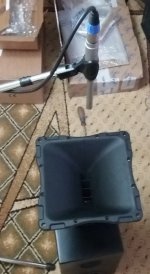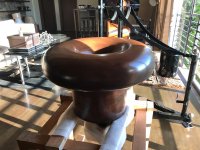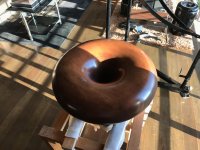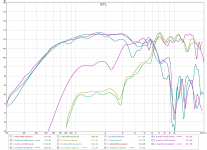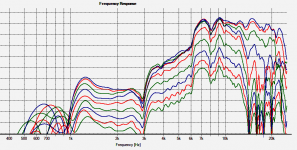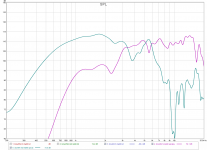Hey Alessandro,
The coax uses a copper cap on the HF section only, we found no benefit to using any shorting device on the MF section. Regarding the horn, I am unaware of any off the shelf horn that can go to 300Hz. We use two large horns in testing and measurement at B&C, the one used for the data sheet is attached.
Got it, thanks a lot! 😉
Just for comparison:
DCX464 Coaxial
Specificatoins MF Unit Inductance = 0.28 mH
==========
A TD15M 15" midbass from AES has similar inductance. L= 0.3mH @1,000Hz
A Satori 1.1" dome tweeter has 1/10 the inductance Le=0.02mH
DCX464 Coaxial
Specificatoins MF Unit Inductance = 0.28 mH
==========
A TD15M 15" midbass from AES has similar inductance. L= 0.3mH @1,000Hz
A Satori 1.1" dome tweeter has 1/10 the inductance Le=0.02mH
Until we see a comparison with bms, here is a brief comparison between some drivers: b&c dcx464 16ohms, jbl d2 wired in parallel, 18sound nd3sa, electrovoice nd6a, with b&c me90, rcf hf950 and jbl vtx f15 horns.
Attachments
-
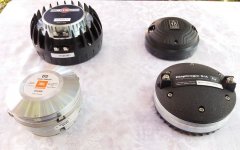 20190821_165830.jpg136.9 KB · Views: 1,132
20190821_165830.jpg136.9 KB · Views: 1,132 -
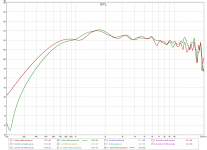 7.png61.3 KB · Views: 522
7.png61.3 KB · Views: 522 -
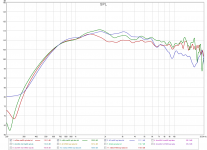 6.png70.6 KB · Views: 495
6.png70.6 KB · Views: 495 -
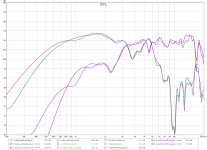 5.png99.4 KB · Views: 478
5.png99.4 KB · Views: 478 -
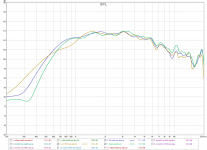 4.png66.9 KB · Views: 477
4.png66.9 KB · Views: 477 -
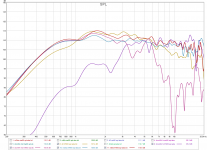 3.png112.5 KB · Views: 487
3.png112.5 KB · Views: 487 -
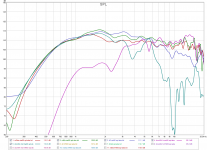 2.png102.5 KB · Views: 1,074
2.png102.5 KB · Views: 1,074 -
 1.png167.8 KB · Views: 1,075
1.png167.8 KB · Views: 1,075 -
 20190821_170451.jpg139.7 KB · Views: 1,095
20190821_170451.jpg139.7 KB · Views: 1,095 -
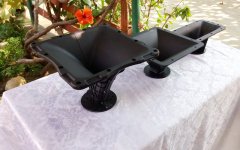 20190821_170534.jpg161.7 KB · Views: 1,102
20190821_170534.jpg161.7 KB · Views: 1,102
LineSource:
One can't simply compare inductances alone without taking into account what effect they could have. On a woofer the inductance may vary much more as a function of excursion than on a compression driver (which are usually underhung anyway).
And it is much easier to keep the inductance of a tiny little 1" tweeter low compared to a compression midrange with a voice-coil diameter of several inches. Keep in mind that if everyting else was kep equal the inductance of a coil is increasing with the square of its diameter.
Regards
Charles
One can't simply compare inductances alone without taking into account what effect they could have. On a woofer the inductance may vary much more as a function of excursion than on a compression driver (which are usually underhung anyway).
And it is much easier to keep the inductance of a tiny little 1" tweeter low compared to a compression midrange with a voice-coil diameter of several inches. Keep in mind that if everyting else was kep equal the inductance of a coil is increasing with the square of its diameter.
Regards
Charles
@ionutgaga
Thank you. Could you please tell us more about the test-setup you are using? Are the horns mounted on some baffle? Is there a high-pass involved? Could you measure impedance, too?
Ah, and one personal request - since I have a slight red/green blindness - most of the colors look very much the same to me - would it be possible to change some of them (or maybe use dotted/dashed lines) ?
Thank you. Could you please tell us more about the test-setup you are using? Are the horns mounted on some baffle? Is there a high-pass involved? Could you measure impedance, too?
Ah, and one personal request - since I have a slight red/green blindness - most of the colors look very much the same to me - would it be possible to change some of them (or maybe use dotted/dashed lines) ?
Looks promising!
I have a horn for the b&c dcx464. Hihi.
Can the guys from B&C shoot me a message regarding the product details like the exit design so we can properly assess if it likes a fastflare or slow opening horn throat. Also question on the acquisition. Would like to test it. Planning on testing this one and the new Celestion. Grinding out alot of top compression drivers in my place looking for the one that works out best. Id like to believe that the inherent beaming issues with such a wide bandwidth driver is so called now resolved with the new b&c. How we wish it would be true to have a big horn that covers 300hz-18k without beaming. Just the thought is worth testing out if the boys from b&c pulls it off.
I have a horn for the b&c dcx464. Hihi.
Can the guys from B&C shoot me a message regarding the product details like the exit design so we can properly assess if it likes a fastflare or slow opening horn throat. Also question on the acquisition. Would like to test it. Planning on testing this one and the new Celestion. Grinding out alot of top compression drivers in my place looking for the one that works out best. Id like to believe that the inherent beaming issues with such a wide bandwidth driver is so called now resolved with the new b&c. How we wish it would be true to have a big horn that covers 300hz-18k without beaming. Just the thought is worth testing out if the boys from b&c pulls it off.
Attachments
Hi Victorsierra,
Regarding the exit angle of the DCX464, I asked the tech-guys at B&C, and the exit angle is zero ("0").
Best regards
Peter
Regarding the exit angle of the DCX464, I asked the tech-guys at B&C, and the exit angle is zero ("0").
Best regards
Peter
I have a horn for the b&c dcx464. Hihi.
Can the guys from B&C shoot me a message regarding the product details like the exit design so we can properly assess if it likes a fastflare or slow opening horn throat. Also question on the acquisition. Would like to test it. Planning on testing this one and the new Celestion. Grinding out alot of top compression drivers in my place looking for the one that works out best. Id like to believe that the inherent beaming issues with such a wide bandwidth driver is so called now resolved with the new b&c. How we wish it would be true to have a big horn that covers 300hz-18k without beaming. Just the thought is worth testing out if the boys from b&c pulls it off.
I found some measurements on this site https://www.prodance.cz/data/attachments/BMS4593ND.pdf , which should be similar to mine, the same horn me90, now with a bms 4593 driver , and even a eaw kf394 https://www.prodance.cz/data/attachments/mereni_eaw_kf394+kf394nt.pdf , wich according with Polar response & Speaker Orientation. should have a bms4594nd. I imported the measurements into the rew software, and this should be the difference between these coaxials.
Attachments
I found some measurements on this site https://www.prodance.cz/data/attachments/BMS4593ND.pdf , which should be similar to mine, the same horn me90, now with a bms 4593 driver , and even a eaw kf394 https://www.prodance.cz/data/attachments/mereni_eaw_kf394+kf394nt.pdf , wich according with Polar response & Speaker Orientation. should have a bms4594nd. I imported the measurements into the rew software, and this should be the difference between these coaxials.
Thanks a ton for the comparison!
As its hard to see for me too, do you mind plotting mid hi of the two drivers with different colours?
How is the sound of it? (Outside the measurements) quality wise.
I think you really need to look at more polars to make any conclusions. I've measured BMS 4593ND - this is the HF section on a big OSWG. Not very nice overall, once you see it all -
(0 - 80 deg / 10deg, SPL division is 5 dB). Remember that the on-axis behaviour means very little for the overall in-room sound.
(0 - 80 deg / 10deg, SPL division is 5 dB). Remember that the on-axis behaviour means very little for the overall in-room sound.
Attachments
The off-axis behaviour can be very different for the different drivers. It depends on the details of the exit wavefront which can be erratic in these co-axial design. You can clearly see it from my measurement. Your pictures are really just a part of the story.
So we are all, instead of thanking for having this, we better put sticks in the wheels.
The measurements are made with 3 different horns, onaxis. Offaxis, the behavior of the horn is the one that dictates to a large extent what is happening.
The measurements are made with 3 different horns, onaxis. Offaxis, the behavior of the horn is the one that dictates to a large extent what is happening.
Last edited:
Oh, come on. 🙂 Of course I'm grateful for this. I know of no one else with all these drivers at stack. I only tried to motivate by example to make some more sets of the data, it would tell a lot (and I mean a lot) more... 
- So, is the new DCX worth it, after all? (I just can't say from the data shown - I can't tell what's correctable and what is not.)

- So, is the new DCX worth it, after all? (I just can't say from the data shown - I can't tell what's correctable and what is not.)
Last edited:
It's quite obvious the DCX is the new benchmark coaxial.
This was actually predictable based on the specsheets.
Just don't expect the response to be comparable to a single large diaphram driver.
This was actually predictable based on the specsheets.
Just don't expect the response to be comparable to a single large diaphram driver.
Last edited:
I don't know of any current "benchmark coaxial" so I can't really comment.
Speaking of DCX464, from what has been shown so far, frankly I'm glad I didn't buy it (yet).
Speaking of DCX464, from what has been shown so far, frankly I'm glad I didn't buy it (yet).
Coaxials are not ideal for OS waveguides.
Who knows what the wavefront (exactly) looks like?
On paper the HF1440 is promising, except for the radial phaseplug.
Who knows what the wavefront (exactly) looks like?
On paper the HF1440 is promising, except for the radial phaseplug.
Last edited:
It's quite obvious the DCX is the new benchmark coaxial.
This was actually predictable based on the specsheets.
Just don't expect the response to be comparable to a single large diaphram driver.
Freq diagrams look a bit jumpy though?!
(Im nothing compared to your knowledge of course)
- Home
- Loudspeakers
- Multi-Way
- B&C DCX464
